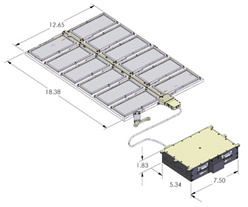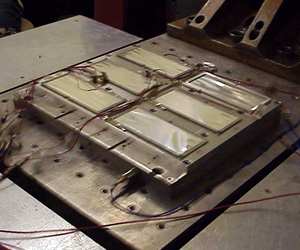Design & Testing
Design

A diagram of the SDC instrument. (Courtesy LASP)
Compared to previous, similarly designed dust counters, the SDC is lighter—only 1.6 kilograms (3.5 pounds)—uses less power, and was much less expensive to develop. Stringent constraints on mass, power, and budget are part of any planetary or space mission; these characteristics help make SDC an attractive dust instrument for future missions.
The SDC has a set of detectors, about the size of an 18 x 12-inch cake pan, which detect incoming particles. The detectors are made of a plastic film called Polyvinylidine Fluoride (PVDF). The detectors are all mounted to a large piece of honeycombed aluminum, which is then bolted with aluminum feet to the New Horizons spacecraft.
When the detectors sense the impact of a dust particle, they send a signal to a processor, made up of circuit boards and wires and connected to the detector by a harness. The processor then sends this interpreted signal to the transmitter on the New Horizons spacecraft. The transmitter streams the data back to Earth in the form of radio waves.
Testing

Spare SDC detectors undergoing a ‘shake’ test. (Courtesy LASP)
All of the materials used on the SDC required stringent testing and verification in order to ensure that they can withstand the rigors of space.
The entire instrument underwent several tests, including heating and cooling in a thermal vacuum test, exposure to electromagnetic interference in an EMI/EMC test and shaking (similar to that of a launch) in a vibrational test.
After each test, the instrument was checked and every piece examined to confirm that all materials in the SDC could survive the space environment.






